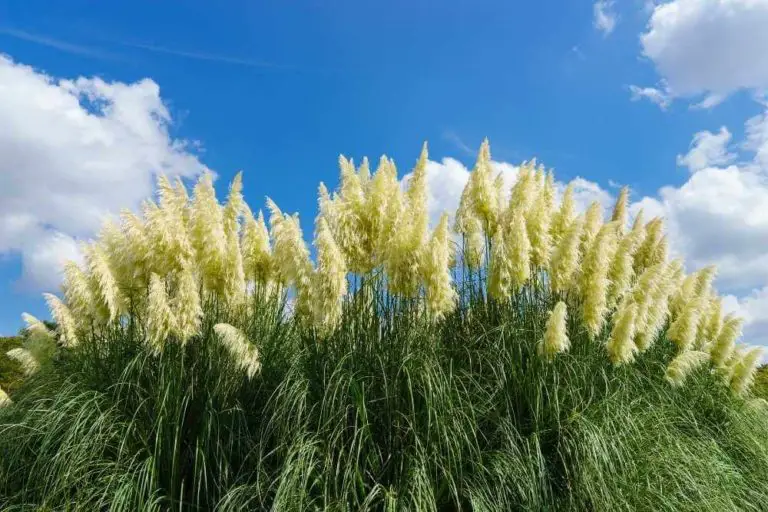Heralded for its graceful appearance and feather-like plumes, Pampas Grass (Cortaderia selloana) has long been a favored choice in landscapes and gardens. However, its rapid growth, invasive nature, and propensity to dominate other plant species have made it a headache for many gardeners, landscape designers, and homeowners.
If you find yourself grappling with this persistent intruder, fear not! In this comprehensive guide, we will explore the ins and outs of Pampas Grass, uncovering the most effective methods to kill and remove it. Whether you are a seasoned landscape designer or a novice gardener, this article will equip you with the knowledge to bid farewell to Pampas Grass once and for all.
Understanding Pampas Grass Plants
Before diving into the eradication methods, it’s crucial to familiarize ourselves with the formidable foe we face. Pampas Grass, native to South America, is a large perennial grass known for its striking appearance and ability to thrive in a variety of climates. With its tall stature, reaching up to 10 feet in height, and its magnificent plumes that shimmer in the breeze, it’s no wonder Pampas Grass has captivated the hearts of many garden enthusiasts.
However, beneath its enchanting allure lies a menacing invader. Pampas Grass is an aggressive plant that spreads rapidly through an extensive root system, crowding out native vegetation and disrupting natural ecosystems. Its long, sharp-edged leaves can cause injury if mishandled, warranting caution during removal.
MORE: Why is Pampas Grass Bad
8 Effective Methods to Kill Pampas Grass
Now that we have acquainted ourselves with the tenacious nature of Pampas Grass, it’s time to explore 8 effective methods to kill and eradicate this resilient plant. The methods outlined below have proven successful in combating this resilient plant:
1. Physical Removal
Physical removal is a straightforward and hands-on approach to eliminate Pampas Grass. This method involves manually cutting down the grass and digging up its root system. Here’s a step-by-step guide to help you:
- Begin by wearing protective clothing, including long-sleeved shirts, pants, gloves, and eye protection.
- Wrap your pampas grass in duct tape, you’ll have a much easier time cleaning up after you cut it down.
- Trim the plumes of the grass as close to the ground as possible to prevent seed dispersal.
- Carefully remove the foliage layer by layer, revealing the central clump of roots.
- Use a shovel or a spade to dig around the base of the clump, loosening the soil.
- Firmly grip the clump and lift it from the ground, ensuring you remove as much of the root system as possible.
- Dispose of the plant material properly, as Pampas Grass can regenerate from fragments.

Check the latest price on Amazon
2. Herbicidal Control
Herbicidal control can be an effective method, especially for larger infestations. By utilizing herbicides specifically formulated to target grasses, you can eliminate Pampas Grass more efficiently. Follow these steps for effective herbicidal control:
- Choose an herbicide that contains glyphosate, as it is known for its effectiveness against Pampas Grass. Read and follow the manufacturer’s instructions carefully.
- Wear protective clothing, including gloves, a face mask, and eye protection.
- Apply the herbicide directly to the foliage of the Pampas Grass, ensuring thorough coverage.
- Monitor the treated area for regrowth and reapply the herbicide as necessary.

Check the latest price on Amazon
3. Solarization
Solarization is an eco-friendly method that uses the sun’s heat to kill Pampas Grass. This technique is best suited for smaller infestations or areas where physical removal may not be feasible. Here’s how to utilize solarization:
- Cut down the foliage of the grass and remove any dead material.
- Rake the area to create a level surface, removing debris and rocks.
- Thoroughly wet the ground to ensure good soil moisture.
- Cover the area with a clear plastic sheet, securing the edges with rocks or soil to create an airtight seal.
- Leave the plastic sheet in place for several months, preferably during the hot summer season when the sun’s rays are most intense.
- The heat trapped under the plastic will raise the temperature of the soil, effectively killing the Pampas Grass and its root system.

Check the latest price on Amazon
4. Smothering
Smothering is a method that deprives Pampas Grass of light and resources, ultimately leading to its demise. Follow these steps to smother Pampas Grass:
- Cut the foliage of the grass as close to the ground as possible.
- Cover the area with a thick layer of mulch, such as wood chips or cardboard.
- Ensure the mulch completely covers the Pampas Grass, preventing sunlight from reaching it.
- Monitor the area regularly and replenish the mulch as needed to maintain coverage.
- Over time, the lack of light and resources will weaken and kill the Pampas Grass.

Check the latest price on Amazon
5. Cutting and Tarping
Cutting and tarping is a method that combines physical removal with the use of a tarp to suffocate Pampas Grass. Follow these steps to implement this approach:
- Cut the grass down to the ground, removing as much foliage as possible.
- Cover the area with a sturdy tarp, ensuring it completely covers the Pampas Grass.
- Secure the tarp’s edges with rocks or weights to create an airtight seal.
- Leave the tarp in place for an extended period, typically several months or more.
- The lack of sunlight and airflow will weaken and eventually kill the Pampas Grass.

Check the latest price on Amazon
6. Repeated Mowing
Repeated mowing can be an effective method to control Pampas Grass and prevent it from spreading. Follow these guidelines for successful repeated mowing:
- Mow the grass regularly, cutting it as close to the ground as possible.
- Dispose of the mowed grass properly to prevent regrowth.
- Consistently repeat the mowing process to weaken the Pampas Grass over time.
- Be vigilant and persistent, as Pampas Grass can be resilient and may require frequent mowing for an extended period.

Check the latest price on Amazon
7. Burning
Burning is a drastic method that should only be considered in areas where it is legal and safe to do so. This method is most effective for large-scale infestations. Here are important considerations for burning Pampas Grass:
- Check local regulations and obtain any necessary permits before proceeding.
- Ensure you have the proper safety equipment, including fire-resistant clothing, gloves, and firefighting tools.
- Choose a time when weather conditions are suitable for controlled burning, avoiding windy or dry periods.
- Create a firebreak around the area to prevent the fire from spreading.
- Ignite the Pampas Grass, carefully monitoring the burn to ensure it remains under control.
- Exercise extreme caution and prioritize safety during the burning process.
8. Seeking Professional Assistance
If the infestation seems overwhelming or the methods mentioned above are not feasible, it may be best to seek professional assistance. Expert landscape designers, gardeners, or specialized removal services can provide tailored strategies and execute effective removal techniques, ensuring the eradication of Pampas Grass and preventing its regrowth.
Why Does Getting Rid of Pampas Grass?
Getting rid of pampas grass (Cortaderia selloana) is a common practice for several reasons. While pampas grass is visually appealing and can add a touch of beauty to landscapes, there are factors that make its removal necessary or desirable. Here are some reasons why people choose to get rid of pampas grass:
- Invasive Nature: Pampas grass is considered an invasive species in many regions outside its native habitat. Its vigorous growth, ability to spread rapidly through rhizomes, and prolific seed production can lead to the displacement of native plants and disrupt local ecosystems. Removing pampas grass helps prevent its spread and protects the biodiversity of the surrounding environment.
- Space Management: Pampas grass can grow quite large and take up a significant amount of space in a garden or landscape. Its towering size and dense clumps can overpower other plants and restrict their growth. Removing pampas grass allows for better space management, enabling the cultivation of other desired plants or creating a more balanced and aesthetically pleasing landscape.
- Fire Hazard: Pampas grass has high flammability, especially when dry. Its dried plumes and foliage can become a significant fire hazard in areas prone to wildfires or where fire safety is a concern. Removing pampas grass reduces the risk of fire and helps ensure the safety of the property and surrounding areas.
- Aesthetic Preferences: Every individual has unique aesthetic preferences for their garden or landscape. Some may find pampas grass to be visually overpowering or incompatible with their desired design style.
It’s important to note that the decision to get rid of pampas grass should be made responsibly and in accordance with local regulations. In areas where pampas grass is classified as an invasive species, proper disposal methods and eradication techniques should be followed to prevent its spread during removal.
What is the best way to kill pampas grass?
The best way to kill pampas grass depends on individual circumstances and preferences. Some effective methods include physical removal by digging out the plant and its roots, applying herbicides specifically designed for grassy weeds like glyphosate-based products, smothering the grass by covering it with plastic or mulch, or seeking professional assistance for larger or more challenging patches. Regular monitoring and follow-up treatments are important to prevent regrowth. It’s crucial to adhere to local regulations for the disposal of pampas grass and consider the environmental impact of the chosen method.
FAQs
While vinegar is often touted as a natural weed killer, its effectiveness in killing pampas grass is limited. Vinegar, especially household vinegar with a 5% acetic acid concentration, may burn the foliage of pampas grass upon direct application. However, it is unlikely to kill the plant completely, especially if the roots are well-established. Pampas grass has a resilient root system that can withstand vinegar treatments. For effective control, it is generally recommended to use more targeted approaches such as physical removal, herbicide application, or a combination of both.
READ MORE: Will Vinegar Kill Pampas Grass
Bleach is not a recommended method for killing pampas grass. While bleach is a strong disinfectant, it is not effective in eradicating pampas grass. Pampas grass has a robust root system, and bleach is not capable of reaching and effectively killing the roots. Moreover, applying bleach to the plant can harm surrounding vegetation and disrupt the balance of the soil. It is important to choose more targeted and appropriate methods for controlling and removing pampas grass, such as physical removal, herbicide application, or professional assistance if needed.
READ MORE: Will Bleach Kill Pampas Grass
Conclusion
Removing and eradicating Pampas Grass may require persistence and effort, but armed with the knowledge and techniques outlined in this article, you are well-prepared to face the challenge head-on. Whether you choose physical removal, herbicidal control, solarization, or seek professional assistance, remember to adapt the methods to suit your unique circumstances and adhere to local regulations.
By taking action against Pampas Grass, you not only regain control of your landscape but also protect the native vegetation and preserve the natural balance of ecosystems. Embrace the journey of Pampas Grass removal and create a thriving garden where native plants can flourish without the encroachment of this invader.
So, roll up your sleeves, put on your gloves, and embark on a journey to conquer Pampas Grass. Your commitment and determination will result in a landscape that showcases the beauty of well-maintained gardens and promotes the diversity of native flora. Get ready to bid farewell to Pampas Grass and welcome a vibrant and balanced ecosystem into your outdoor oasis!
Note: Always follow local regulations and environmental guidelines when removing Pampas Grass.










